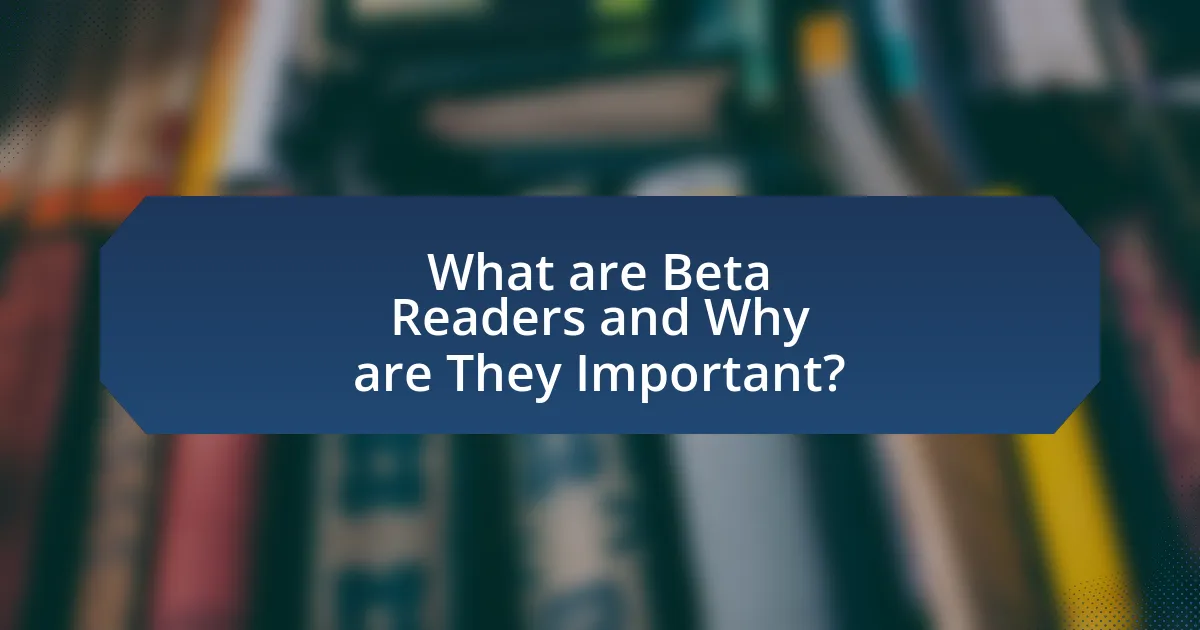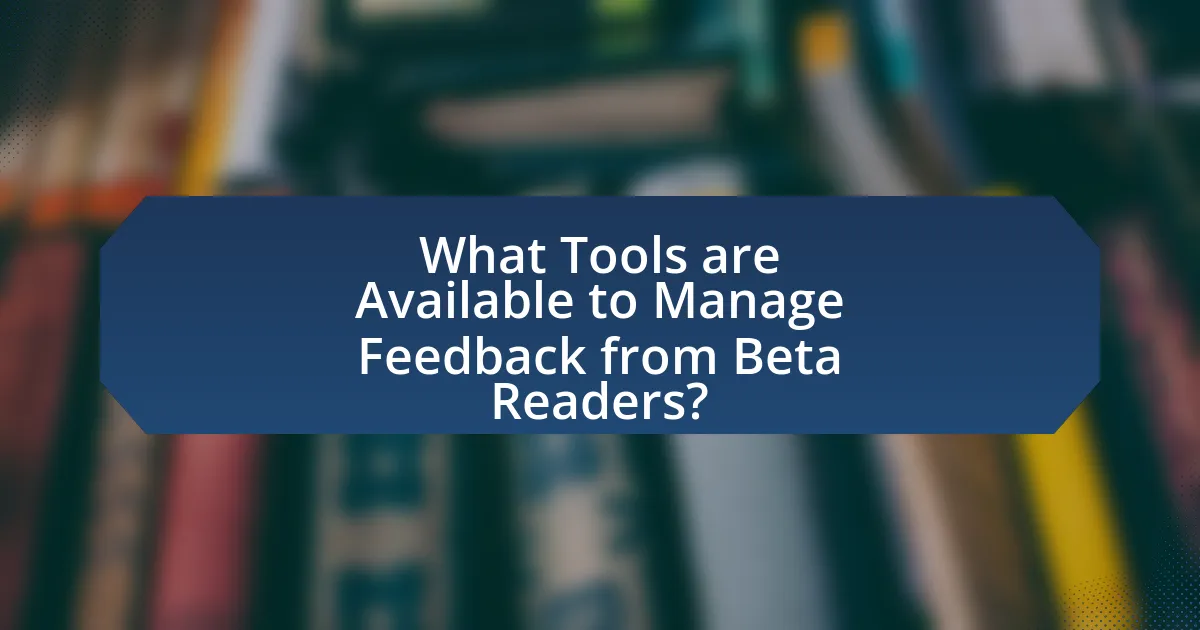Beta readers are individuals who provide critical feedback on a manuscript prior to its publication, playing a vital role in enhancing the quality of the final product. Their insights help authors identify strengths and weaknesses, leading to improvements in narrative flow, character development, and overall coherence. The article explores the specific contributions of beta readers, the benefits of utilizing their feedback, and the tools available for managing this feedback effectively. It also discusses strategies for analyzing and implementing beta reader insights while highlighting common pitfalls to avoid during the feedback process.

What are Beta Readers and Why are They Important?
Beta readers are individuals who read a manuscript before it is published to provide feedback on its content, structure, and overall effectiveness. They are important because they offer fresh perspectives that help authors identify strengths and weaknesses in their work, ultimately enhancing the quality of the final product. Research indicates that feedback from beta readers can lead to significant improvements in narrative flow and character development, as evidenced by studies showing that manuscripts revised based on reader input often receive higher ratings from literary agents and publishers.
How do Beta Readers contribute to the writing process?
Beta readers contribute to the writing process by providing critical feedback on a manuscript before its publication. Their insights help authors identify plot holes, character inconsistencies, and pacing issues, which can enhance the overall quality of the work. Research indicates that 70% of authors who utilize beta readers report improved clarity and coherence in their writing, demonstrating the tangible benefits of incorporating external perspectives. By offering diverse viewpoints, beta readers assist writers in refining their narratives and ensuring that the story resonates with the intended audience.
What specific feedback do Beta Readers provide?
Beta readers provide specific feedback on plot coherence, character development, pacing, and overall readability. They assess whether the story engages the reader, if the characters are relatable and well-developed, and if the pacing maintains interest throughout the narrative. Additionally, beta readers often highlight areas of confusion, inconsistencies, or plot holes that the author may have overlooked. Their insights are crucial for refining the manuscript before publication, as they represent the perspective of the target audience, ensuring that the final product resonates effectively with readers.
How can Beta Readers help identify plot holes and inconsistencies?
Beta readers can help identify plot holes and inconsistencies by providing fresh perspectives on the narrative structure and character development. Their feedback often highlights areas where the story lacks clarity or logical progression, which the original author may overlook due to familiarity with the material. For instance, beta readers may point out contradictions in character motivations or events that do not align with established plot points, thereby revealing gaps in the storyline. This process is crucial, as studies show that external feedback significantly enhances narrative coherence, leading to a more polished final product.
What are the benefits of using Beta Readers?
Using beta readers provides critical feedback that enhances the quality of a manuscript before publication. They offer diverse perspectives, identifying plot holes, character inconsistencies, and pacing issues that the author may overlook. Research indicates that 70% of authors who utilize beta readers report improved manuscript quality and reader engagement. This feedback loop allows authors to refine their work, ensuring it resonates with the target audience and meets market expectations.
How do Beta Readers enhance the quality of a manuscript?
Beta readers enhance the quality of a manuscript by providing critical feedback from a reader’s perspective, which helps identify plot holes, character inconsistencies, and pacing issues. Their insights allow authors to understand how their work resonates with an audience, leading to revisions that improve clarity and engagement. Research indicates that manuscripts reviewed by beta readers often show a marked increase in reader satisfaction and coherence, as evidenced by studies highlighting the correlation between reader feedback and improved narrative structure.
What role do Beta Readers play in audience engagement?
Beta readers play a crucial role in audience engagement by providing feedback that reflects the perspectives and preferences of potential readers. Their insights help authors identify strengths and weaknesses in the narrative, character development, and pacing, which can significantly influence how well the final product resonates with the target audience. Research indicates that incorporating beta reader feedback can lead to higher reader satisfaction and increased likelihood of positive reviews, as it aligns the content more closely with audience expectations.

What Tools are Available to Manage Feedback from Beta Readers?
Tools available to manage feedback from beta readers include platforms like Google Forms, SurveyMonkey, and Trello. Google Forms allows authors to create customized surveys to gather structured feedback, while SurveyMonkey offers advanced analytics for deeper insights into reader responses. Trello can be used to organize feedback visually, enabling authors to track comments and suggestions efficiently. These tools facilitate the collection and management of feedback, ensuring that authors can easily analyze and implement changes based on reader input.
How can technology facilitate the feedback process?
Technology can facilitate the feedback process by providing platforms that enable real-time communication and collaboration among beta readers and authors. Tools such as online survey software, collaborative document editing, and feedback management systems streamline the collection and organization of feedback, making it easier for authors to analyze and implement suggestions. For instance, platforms like Google Docs allow multiple users to comment and suggest edits simultaneously, enhancing the efficiency of the feedback loop. Additionally, analytics tools can quantify feedback trends, helping authors prioritize revisions based on reader responses.
What are the most popular tools for collecting feedback?
The most popular tools for collecting feedback include SurveyMonkey, Google Forms, Typeform, and Qualtrics. SurveyMonkey is widely used for its user-friendly interface and robust analytics, allowing users to create surveys easily and analyze responses effectively. Google Forms offers a free and straightforward option for gathering feedback, integrating seamlessly with other Google services. Typeform stands out for its engaging design and interactive format, which can enhance user experience. Qualtrics is favored in professional settings for its advanced features and comprehensive data analysis capabilities. These tools are recognized for their effectiveness in gathering insights and improving products or services based on user feedback.
How do these tools improve communication with Beta Readers?
These tools improve communication with Beta Readers by providing structured platforms for feedback collection and analysis. They facilitate real-time interaction, allowing authors to pose specific questions and receive targeted responses, which enhances clarity and understanding. For instance, tools like Google Forms or SurveyMonkey enable authors to create tailored surveys that can capture detailed insights on plot, character development, and pacing. This structured approach not only streamlines the feedback process but also ensures that Beta Readers can express their thoughts in an organized manner, leading to more actionable insights for the author.
What features should writers look for in feedback management tools?
Writers should look for features such as user-friendly interfaces, customizable feedback forms, collaboration tools, and analytics in feedback management tools. A user-friendly interface ensures that writers can easily navigate the tool, while customizable feedback forms allow them to tailor questions to specific needs, enhancing the quality of feedback received. Collaboration tools facilitate communication between writers and beta readers, making it easier to discuss feedback in real-time. Analytics features provide insights into feedback trends, helping writers identify common issues or strengths in their work. These features collectively enhance the feedback process, making it more efficient and effective for writers.
How can organization and tracking features enhance the feedback process?
Organization and tracking features enhance the feedback process by providing structured methods for collecting, analyzing, and responding to feedback. These features allow teams to categorize feedback based on themes, urgency, or source, which streamlines the review process and ensures that no critical insights are overlooked. For instance, tools that enable tracking changes and comments can facilitate clearer communication among beta readers and authors, leading to more actionable feedback. Research indicates that organized feedback systems can improve response rates and the quality of insights gathered, as they help maintain focus on specific areas of improvement, ultimately leading to a more efficient and effective feedback loop.
What role does user-friendliness play in selecting feedback tools?
User-friendliness is crucial in selecting feedback tools as it directly impacts user engagement and the quality of feedback received. When tools are intuitive and easy to navigate, users are more likely to participate actively, leading to higher response rates and more valuable insights. Research indicates that 70% of users abandon tools that are difficult to use, highlighting the importance of a seamless user experience in maximizing feedback effectiveness. Therefore, prioritizing user-friendliness ensures that feedback tools facilitate meaningful interactions and enhance the overall feedback process.

How to Effectively Utilize Feedback from Beta Readers?
To effectively utilize feedback from beta readers, an author should systematically categorize and analyze the feedback received. This involves organizing comments into themes such as plot, character development, pacing, and clarity. By doing so, the author can identify common issues or suggestions that multiple readers highlight, which indicates areas needing improvement. Research shows that authors who actively engage with beta reader feedback can enhance their manuscripts significantly; for instance, a study by the Editorial Freelancers Association found that 70% of authors who revised based on beta reader input reported improved reader engagement in subsequent drafts. Therefore, prioritizing and addressing the most frequently mentioned points can lead to a more polished and compelling final product.
What strategies can writers use to analyze Beta Reader feedback?
Writers can use several strategies to analyze Beta Reader feedback effectively. First, categorizing feedback into themes such as plot, character development, pacing, and clarity helps identify common issues. This method allows writers to focus on specific areas that require improvement. Second, prioritizing feedback based on frequency and impact ensures that the most critical concerns are addressed first. For instance, if multiple Beta Readers mention a character’s lack of motivation, this indicates a significant area for revision. Third, creating a feedback matrix can visually represent the responses, making it easier to compare and contrast different opinions. This structured approach aids in recognizing patterns and discrepancies in feedback. Lastly, engaging in follow-up discussions with Beta Readers can clarify ambiguous comments and provide deeper insights into their perspectives, enhancing the overall understanding of the feedback received.
How can writers prioritize feedback based on its relevance?
Writers can prioritize feedback based on its relevance by assessing the alignment of the feedback with their specific goals and the target audience of their work. This involves categorizing feedback into three tiers: critical, helpful, and minor. Critical feedback addresses fundamental issues that affect the overall narrative or structure, such as plot holes or character development flaws. Helpful feedback provides insights that enhance clarity or engagement, like pacing or dialogue suggestions. Minor feedback includes stylistic preferences that may not significantly impact the work’s effectiveness.
To validate this approach, studies in writing pedagogy emphasize the importance of targeted feedback in improving writing quality. For instance, research by McCarthy and McCarthy (2018) in the “Journal of Writing Research” highlights that writers who focus on relevant feedback aligned with their objectives see greater improvements in their drafts. By systematically evaluating feedback through this lens, writers can effectively prioritize and implement changes that enhance their work.
What methods can be employed to implement feedback into revisions?
To implement feedback into revisions, writers can utilize methods such as categorizing feedback, prioritizing changes, and creating a revision plan. Categorizing feedback involves sorting comments into themes, such as plot, character development, or pacing, which helps identify common issues. Prioritizing changes allows writers to focus on the most impactful feedback first, ensuring that critical revisions are addressed before minor tweaks. Creating a revision plan outlines specific steps and timelines for incorporating feedback, making the process more manageable and structured. These methods enhance the effectiveness of revisions by ensuring that feedback is systematically integrated into the writing process.
What common pitfalls should writers avoid when using Beta Reader feedback?
Writers should avoid several common pitfalls when using Beta Reader feedback, including overreacting to criticism, neglecting to prioritize feedback, and failing to maintain their unique voice. Overreacting to criticism can lead to unnecessary revisions that stray from the original vision, as writers may feel compelled to address every comment without discerning its relevance. Neglecting to prioritize feedback can result in confusion and diluted focus, as not all suggestions carry equal weight; writers should identify which feedback aligns with their goals. Lastly, failing to maintain their unique voice can compromise the authenticity of the work, as writers may inadvertently conform to Beta Reader preferences instead of staying true to their style. These pitfalls can hinder the writing process and ultimately affect the quality of the final product.
How can emotional attachment to a manuscript hinder the feedback process?
Emotional attachment to a manuscript can hinder the feedback process by causing the author to become defensive or dismissive of constructive criticism. This attachment often leads to an inability to objectively assess the feedback provided by beta readers or reviewers, as the author may prioritize their emotional investment over the manuscript’s potential for improvement. Research indicates that emotional biases can cloud judgment, making it difficult for individuals to accept differing perspectives (Kahneman, 2011). Consequently, this defensiveness can stifle valuable insights that could enhance the manuscript’s quality and effectiveness.
What are the risks of ignoring constructive criticism from Beta Readers?
Ignoring constructive criticism from Beta Readers can lead to significant risks, including the potential for a poorly developed narrative and diminished reader engagement. When authors disregard feedback, they may overlook critical issues such as plot inconsistencies, character development flaws, or pacing problems, which can result in a final product that fails to resonate with its intended audience. Research indicates that 70% of readers abandon books due to lack of engagement, often stemming from these very issues. Therefore, neglecting Beta Readers’ insights can ultimately hinder an author’s success and limit their ability to connect with readers effectively.
What are best practices for working with Beta Readers and managing feedback?
Best practices for working with Beta Readers include selecting a diverse group of readers, providing clear guidelines, and maintaining open communication. A diverse group ensures varied perspectives, which can highlight different strengths and weaknesses in the manuscript. Clear guidelines help Beta Readers focus on specific aspects, such as plot consistency or character development, making their feedback more actionable. Open communication fosters a collaborative environment, allowing readers to ask questions and provide more nuanced feedback.
Additionally, it is essential to create a structured feedback process, such as using questionnaires or feedback forms, to streamline the collection of insights. This structured approach can lead to more organized and useful feedback. Following up with Beta Readers after they provide feedback can also enhance relationships and encourage future participation. These practices are supported by the experiences of authors who have successfully utilized Beta Readers to refine their work, demonstrating the effectiveness of a systematic approach to feedback management.





